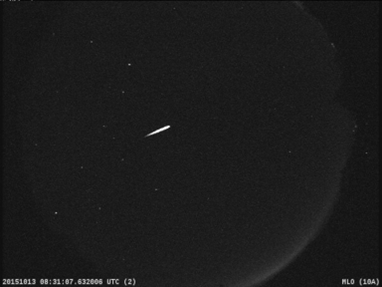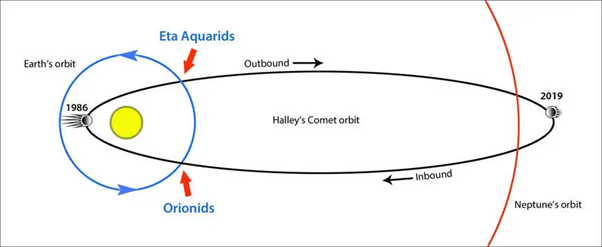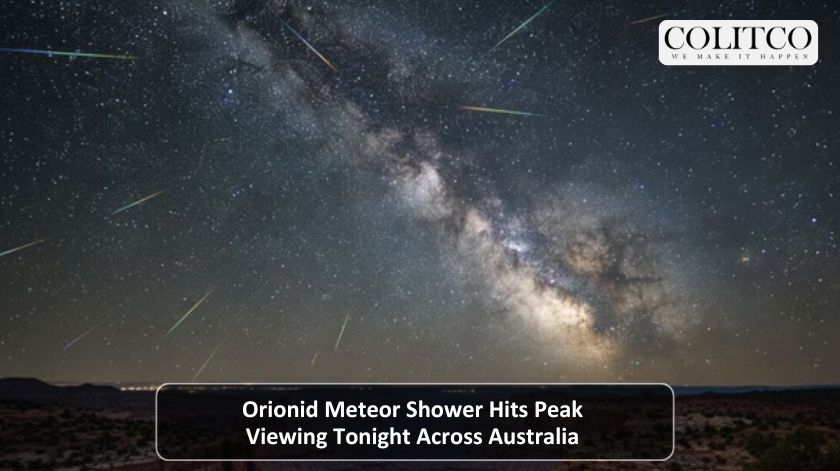Australians are in for a celestial treat tonight as the Orionid meteor shower reaches its peak, offering one of the best viewing opportunities of 2025. The timing couldn’t be better; dark, moonless skies will make even faint meteors visible.
The show runs from now through early Wednesday morning, 22nd October. Expect between 10 and 20 meteors streaking across the sky every hour.
Professor Jonti Horner from the University of Southern Queensland says this is your chance to see fragments left behind by the most famous comet in history. “It’s a really nice opportunity to see fragments left behind by Halley’s Comet,” he told SBS News.
When to Watch the Orionid Meteors in Australia
The best viewing window opens between 3am and 5am AEDT on Wednesday morning. That’s when the Earth faces directly into the debris stream, causing more meteors to appear.

Here’s what makes 2025 special for the Orionid meteor shower Australia viewing:
- New moon conditions mean zero light pollution from the moon
- Dark skies throughout the peak period
- Clear weather forecast for most regions
- Active period extends until 7th November
Northern Australia gets the best show. The further north you are, the more meteors you’ll see.
“The further north you are in Australia, the better show you’ll get,” Horner explained.
You don’t need telescopes or special equipment. Just your eyes and patience. Find a dark spot away from city lights, lie back and look up. Your eyes need about 20 minutes to adjust to the darkness.
Similar to recent aurora australis displays across Australian skies, the Orionids offer another chance to witness spectacular celestial phenomena visible to the naked eye.
What Causes the Orionid Meteor Shower?
Halley’s Comet creates this annual display. The famous comet orbits the Sun every 76 years, dumping dust and debris along its path. When Earth passes through this cosmic trail in October, tiny particles burn up in our atmosphere at speeds exceeding 66 kilometres per second.
The result? Bright streaks of light we call meteors or shooting stars.
Halley’s Comet last appeared in 1986. Scientists expect its return in 2061. But its presence remains felt twice yearly through meteor showers, the Orionids in October and the Eta Aquarids in May.
The meteors appear to radiate from the constellation Orion, which rises in the eastern sky after midnight. Look for Orion’s distinctive belt, three bright stars in a row. The meteors will seem to originate from this area but can appear anywhere in the sky.
How the Orionid Meteor Shower 2025 Stacks Up
Horner manages expectations. The Orionids rank as the “fourth best” meteor shower of the year. They’re good, but not spectacular.
“I view it as a nice warming up,” he said. “We’ve got the best meteor shower of the year coming up in the middle of December.”
The Geminids in December typically produce 50 meteors per hour, nearly three times more than the Orionids. They peak on 14th and 15th December.
Still, the Orionids offer several advantages this year:
- Perfect moon phase (new moon = dark skies)
- Comfortable spring weather
- Long viewing window through early November
- Occasional bright fireballs that outshine stars
Some Orionid meteors leave persistent trains, glowing trails that linger for seconds after the meteor vanishes. These occur when particularly bright meteors vaporise, leaving ionised gas in their wake.
Best Viewing Locations Across Australia
Light pollution remains your biggest enemy. Cities drown out fainter meteors with artificial light. Your best bet? Get out of town.
Dark sky locations offer the most rewarding experience. National parks, rural properties and coastal areas away from major cities provide ideal conditions.
Regional areas in New South Wales, Victoria and South Australia have reported excellent viewing conditions. Tasmania’s southern location offers particularly dark skies, though daylight hours remain short following winter solstice.
If you can’t escape the city, try these tips:
- Find local parks away from streetlights
- Position yourself where buildings block direct light sources
- Use a reclining chair or lie on a blanket
- Look away from the direction of the city centre
- Give your eyes 20-30 minutes to adjust
Weather conditions matter too. Check your local forecast. Cloud cover will ruin the show. The Bureau of Meteorology indicates clear skies across most of eastern Australia through Wednesday morning.
What to Expect During Peak Hours
Realistic expectations prevent disappointment. You won’t see continuous streams of meteors. The advertised “20 per hour” rate translates to one meteor every three to five minutes under ideal conditions.
Patience pays off. Plan to stay outside for at least an hour. Bring warm clothing, Australian spring nights get chilly. A thermos of coffee or tea helps pass the time between meteors.
The meteors themselves appear as quick flashes. Most last less than a second. Some burn brighter than others. Occasionally, a fireball streaks across the sky, leaving a glowing trail that persists for several seconds.
“The brighter ones do produce persistent trains, which are smoke trails after the meteor has disappeared,” explained Robert Lunsford from the American Meteor Society.
You might even spot meteors from other sources. Random space debris burns up in Earth’s atmosphere constantly. Any meteor that doesn’t trace back to Orion’s constellation represents a bonus sighting.
Photography Tips for Meteor Hunters
Smartphones can capture bright meteors, though dedicated cameras work better. Here’s how to photograph the Orionid meteor shower 2025 Australia:
- Use a tripod or stable surface
- Set your camera to manual mode
- Open the aperture wide (f/2.8 or lower)
- Set ISO between 1600-3200
- Use 15-30 second exposures
- Focus on infinity
- Shoot continuously throughout the viewing period
Luck plays a huge role. You’re essentially hoping a meteor appears during your exposure. Take hundreds of shots. A few will capture meteors.
Point your camera away from Orion’s constellation. Meteors farther from the radiant appear longer and more dramatic.
The Science Behind Meteor Showers
Understanding meteor showers adds appreciation to the viewing experience. These aren’t stars falling from the sky. They’re pieces of ancient comets burning up in Earth’s upper atmosphere.
Halley’s Comet formed over 4.5 billion years ago from the same cloud of gas and dust that created our solar system. It’s essentially a dirty snowball, ice mixed with rock and dust.
Each time Halley approaches the Sun, solar radiation vaporises some of its icy surface. This releases trapped dust and debris, creating a trail along its orbital path. Earth’s orbit intersects this trail twice yearly, producing the Orionid and Eta Aquarid meteor showers.
The particles causing tonight’s show are tiny, most smaller than grains of sand. They travel at extraordinary speeds, creating friction with air molecules as they enter the atmosphere. This friction generates heat exceeding 1,650 degrees Celsius, causing the particles to vaporise and glow.
According to NASA, studying meteor showers helps scientists understand the composition of comets and the early solar system.

Diagram showing Earth passing through Halley’s Comet debris trail
Other Celestial Events This Month
The Orionids aren’t the only show in town. October brings several astronomical events worth watching.
The Southern Taurids meteor shower runs concurrently, peaking in early November. These meteors move much slower than Orionids and originate from the constellation Taurus. They’re known for producing bright fireballs.
“It’s kind of like they’re doing battle,” Lunsford said. “Slow meteors are shooting eastward toward Orion, and fast ones are shooting westward toward Taurus.”
Jupiter remains prominently visible in the evening sky. Mars rises late at night, appearing as a reddish dot in the northeastern sky. These planets offer steady viewing targets before the Orionids peak in the early morning hours.
Much like the recent planetary parade that captivated Australian stargazers, these October events remind us of the dynamic nature of our solar system.
Safety and Etiquette for Night Sky Watching
A few reminders ensure everyone enjoys the experience:
- Bring warm layers, temperatures drop significantly after midnight
- Use red torch lights to preserve night vision
- Keep noise levels low if in shared spaces
- Leave no trace, pack out all rubbish
- Respect private property boundaries
- Alert others if using bright lights
- Consider others when parking in rural areas
If photographing, be mindful of others’ viewing experience. Bright camera screens and flash photography disrupt night vision adaptation.
Also Read: Why Big Investors Are Standing By Pilbara Minerals Despite Brutal Year
FAQs About the Orionid Meteor Shower 2025
Q: When is the best time to watch the Orionid meteor shower in Australia?
A: The optimal viewing window runs from 3am to 5am AEDT on Wednesday, 22nd October. The shower remains active through early November, but peak rates occur during these dates.
Q: Do I need special equipment to see the Orionids?
A: No. Telescopes and binoculars actually reduce your field of view, making you miss meteors. Your naked eyes work best for meteor watching.
Q: Why is 2025 a particularly good year for the Orionid meteor shower Australia viewing?
A: The new moon phase means completely dark skies. No moonlight competes with the meteors, allowing you to see even faint streaks.
Q: How many meteors can I expect to see per hour?
A: Under ideal dark-sky conditions, expect 10-20 meteors hourly during peak times. City viewing might reduce this to 5-10 per hour.
Q: What direction should I look?
A: Look anywhere in the sky. While meteors radiate from Orion, they appear throughout the entire sky. Looking away from Orion often reveals longer, more dramatic meteor trails.
Q: Can I see the Orionids from cities?
A: Yes, though light pollution reduces visibility. The brightest meteors remain visible from urban areas, but you’ll miss fainter ones.












